If you buy through our links, we may earn an affiliate commission. This supports our mission to get more people active and outside.Learn about Outside Online's affiliate link policy
The Best Ski Boots of 2026, Tested and Reviewed
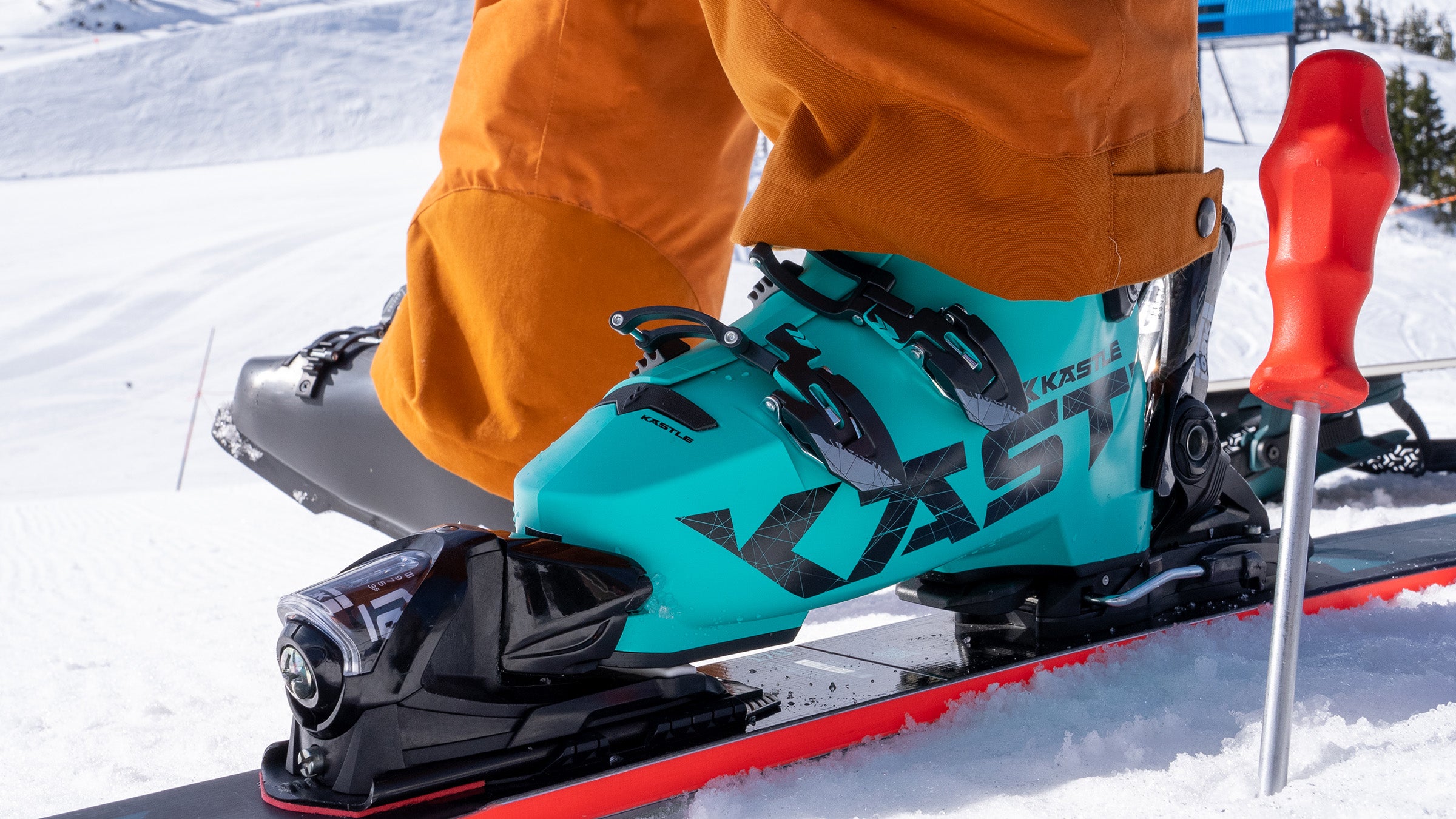
We partnered with the experts at SKI and Masterfit to test 80 ski boots last winter. These 7 are the best of the bunch. (Photo: Courtesy Masterfit/America's Best Bootfitters)
Let’s just get this out of the way: There’s no single “best” ski boot. The right ski boot for you depends entirely on your foot shape, skiing style, ability, and goals. To figure that out, your best move is to visit a reputable ski shop, where a professional bootfitter can help you identify the right model—low volume or high, stiff or soft, BOA dials or traditional buckles?
That said, everyone has to start somewhere. To help narrow the options, we teamed up with SKI and the boot experts at Masterfit/America’s Best Bootfitters to test more than 80 models at their annual boot test last winter. Together, we identified boots that perform and fit exceptionally well across entire product lines—so we could recommend high-performing options for every type of skier, from aggressive experts with narrow feet to easygoing cruisers with small calves or high insteps.
After a week of on-snow testing at Mt. Batchelor, Oregon, we can confidently say this: whoever you are, and however you ski, one of these boots will feel like it was made for you.
The Best Ski Boots: At a Glance
- Editors’ Choice: Lange Shadow ($700-$900)
- Best for Narrow Feet: Nordica Promachine ($600-$850)
- Best for Wide Feet: Salomon S/Pro Delta BOA ($520-$790)
- Easiest On/Off: Rossignol Vizion 4B ($600-$800)
- Best for Carvers: Lange RS ($500-$900)
- Best Backcountry Hybrid: Tecnica Cochise ($650-$850)
- Best Alpine Touring Boot: Scarpa Maestrale/Gea ($799-$899)
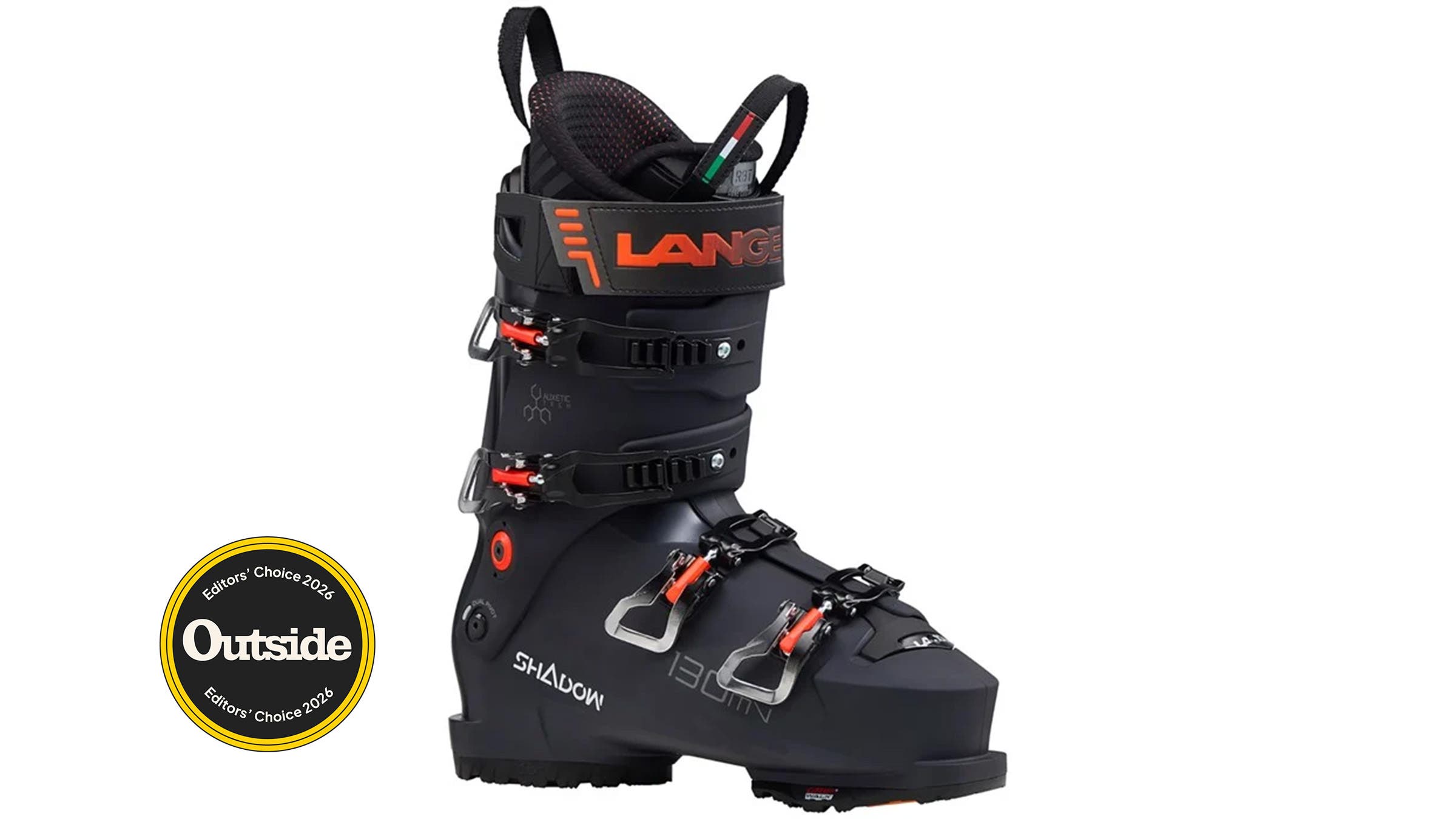
Editors’ Choice: Lange Shadow
Sizes available: 24.5-31.5 (men’s); 22.5-27.5 (women’s)
Volume/Last options: LV (97 mm); MV (100 mm); HV (102 mm)
Flex options: 130, 120, 110 (men’s); 115, 95, 85 (women’s)
Pros and Cons
+ Cushy liner
+ Good energy transfer to the ski
+ Snug fit
– Fits a little short in length
We love the Lange Shadow boot family because there’s truly something for everyone. Whether you’re charging steeps in the 130 flex or cruising groomers in a softer or roomier model, every Shadow boot delivers the same thing: a glove-like fit and a level of power transfer that makes you ski better without you having to try harder.
We tested the Shadow 130 MV, a stiff, mid-volume boot geared toward expert skiers with an average-width foot. What we noticed first was how comfortable this boot was. Much of that comfort comes from Lange’s Auxetic liner, a stretchy, hexagon-patterned fabric that conforms evenly around the foot instead of bunching at pressure points. Slide your foot in and it feels a little like pulling on a new wetsuit bootie: snug, padded, and uniform from heel to toe.
Performance-wise, the Shadow stands apart. Its innovative cuff-to-shell connection creates smoother, more efficient energy transfer. The result is precision and stability on edge with less effort.
A few testers noted that the fit runs a tad short, but not enough to size up. Otherwise, it’s one of the most balanced, confidence-boosting boots we’ve skied. And if you need something a bit softer, narrower, or wider, the rest of the Shadow lineup offers those same standout traits.
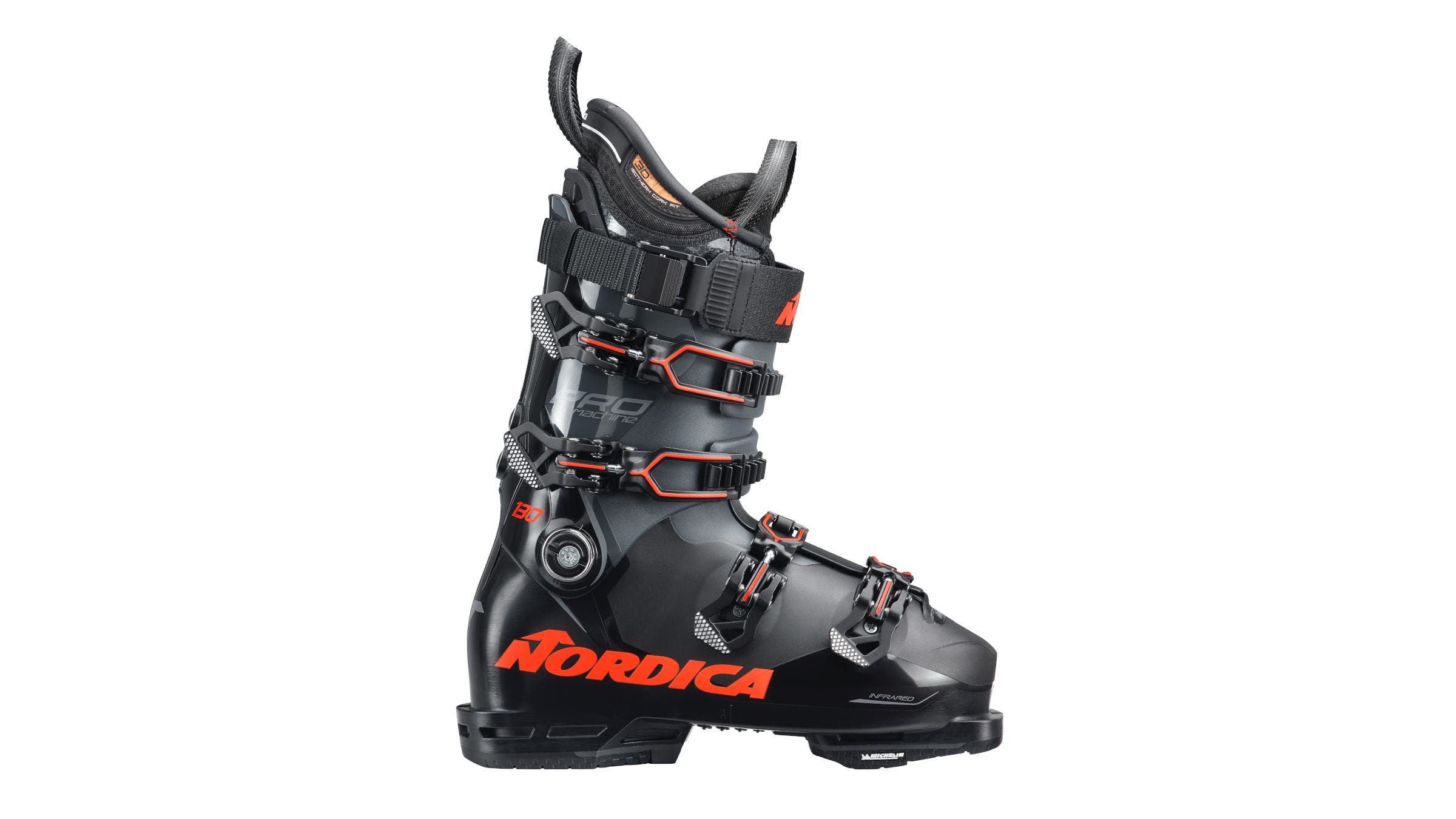
Best for Narrow Feet: Nordica Promachine
Sizes available: 24.5-31.5 (men’s); 22-27.5 (women’s)
Volume/Last options: LV (98 mm)
Flex options: 130, 120, 110, 100, 90 (men’s); 115, 105, 95, 85 (women’s)
Pros and Cons
+ Traditional design and buckles
+ Great power transfer to the ski
+ Surprisingly hotspot free for such a tight fit
– Might not be comfortable enough for casual skiers
If your feet run narrow and you like your ski boots snug, the Nordica Promachine lineup should be at the top of your list. With a 98-millimeter last and multiple flex options (from approachable to race-ready), the Promachine ski boots are tailor-made for skiers who want a performance-driven feel without the pain of a race boot.
Testers have loved the Promachine boots for years, and for good reason: They deliver a pure connection to your skis. The shell has enough shape to ease pressure on bony spots of the foot, and the liner offers just enough cushion to keep toes warm and circulation flowing, without muting feedback. The result is a boot that feels tight and responsive but still wearable.
On snow, the Promachine is all about precision. It’s a no-frills boot—just a classic polyurethane overlap shell with four traditional buckles (no BOA here)—designed to transmit every bit of energy straight to your edges. Testers said it skis exactly where you tell it to go—for better or worse—and rewards strong technique with clean, confident turns.
That no-nonsense design philosophy runs through the entire Promachine family, from the flagship 130-flex model down to the softer, more forgiving versions. No cables, no BOA dials, just a traditional fit that serious skiers trust. If you want a snug, narrow boot that turns every ounce of effort into forward motion, the Promachine delivers, lap after lap.
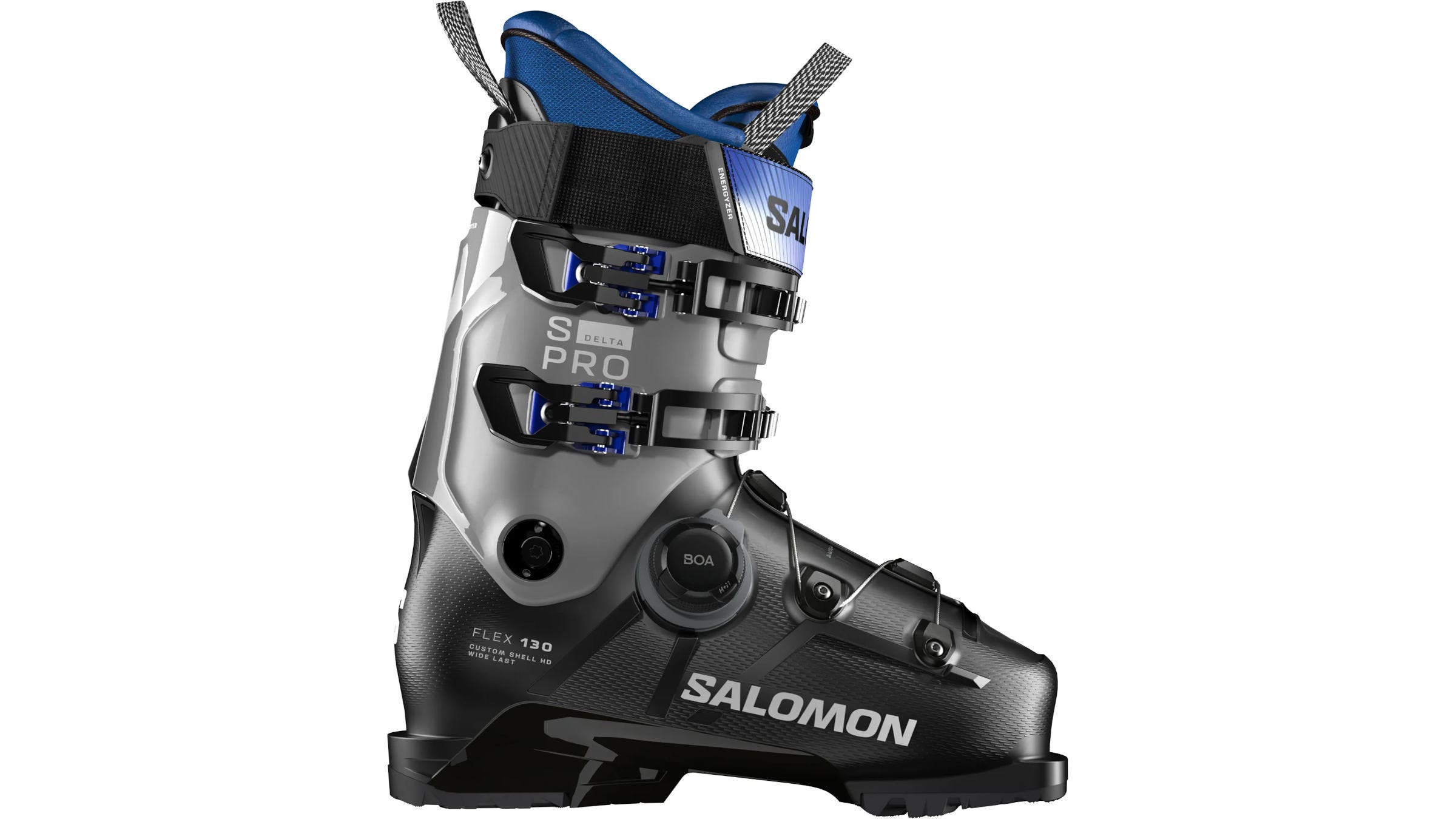
Best for Wide Feet: Salomon S/Pro Delta BOA
Sizes available: 24.0-31.5 (men’s); 22-27.5 (women’s)
Volume/Last options: 102 mm
Flex options: 130, 120, 100 (men’s); 105, 95 (women’s)
Pros and Cons
+ Accommodating fit
+ Comfortable
+ Skis more powerfully than expected
– Might not be high-volume enough for some
For years, Salomon has been refining its alpine boot lineup, focusing on the narrow S/Pro Alpha and the medium-width S/Pro Supra. Now the brand has nailed the wide fit, too. The new S/Pro Delta BOA (available in a range of flex options for both men and women) delivers that same signature performance and comfort, but with a generous 102-millimeter last that gives wide-footed skiers the room they need.
Our testers were immediately impressed with the fit. The S/Pro Delta BOA is easy to step into and once you dial in the BOA closure, the tension feels smooth and even from shin to toe. The boot holds the foot securely without pinching, offers plenty of space through the forefoot and instep, and leaves ample room in the cuff for thicker calves. Even testers with mid-volume feet and legs said they felt supported and locked in, not sloppy. The flipside: Skiers with truly wide feet might need to visit a bootfitter to have the boot’s heat-moldable Custom Shell finetuned for the perfect fit.
Its blend of comfort and precision is what makes the S/Pro Delta BOA stand out. It feels plush on the inside yet delivers efficient energy transfer edge to edge, earning performance scores that rivaled narrower, more “technical” boots. Testers described the S/Pro Delta BOA as quick, lively, and surprisingly powerful—proof that a wide boot doesn’t have to mean a soft or cavernous one.
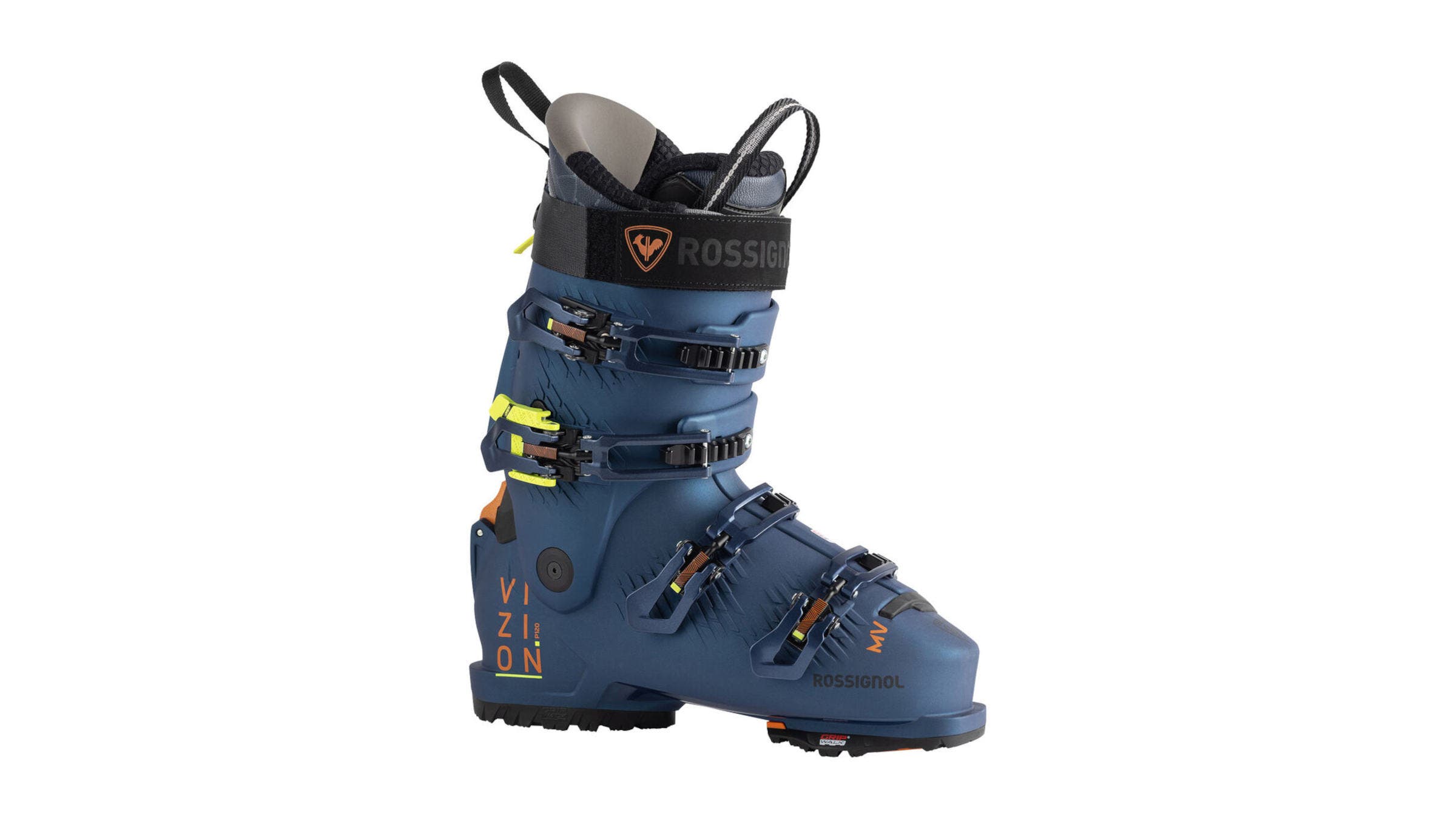
Easiest On/Off: Rossignol Vizion 4B
Sizes available: 24.5-31.5 (men’s); 22.5-27.5 (women’s)
Volume/Last options: LV (98 mm), MV (100 mm), HV (102 mm)
Flex options: 130, 120,100 (men’s); 100, 90, 100 (women’s)
Pros and Cons
+ Strong skiing performance
+ Very easy entry and exit
+ Easy entry mode functions as “après” walk feature
– The cuff can be tricky to buckle up
If you’ve ever wrestled with your ski boots in a frozen parking lot, the Rossignol Vizion 4B Pro might feel like a small miracle. With the flip of a color-coded buckle, the cuff opens wide—really wide—so your foot just slides right in. Getting out is just as easy. There’s a short learning curve to re-buckling the system, but once you’ve done it a few times, it’s effortless. It’s as easy as a classic rear-entry boot, but here’s the kicker: It skis so much better. This is a legit alpine boot, not a compromise.
Available in multiple flexes and widths for both men and women (“Elite” indicates LV models, “Pro” indicates MV models), the Vizion Pro family offers a performance-oriented fit that wraps evenly around the foot without pressure points. Testers loved how secure it felt through the heel and midfoot, yet roomy enough up front to stay comfortable all day.
Once you’re on snow, the Vizion Pro delivers the goods. Testers said it’s every bit as powerful and precise as comparable non-walk-mode boots, with smooth energy transfer and a predictable, confidence-inspiring feel. It carved arcs on hardpack, powered through chop, and handled tight trees with ease.
That rare blend of easy entry, great fit, and strong performance makes the Vizion Pro a standout for anyone tired of the daily boot struggle. It’s proof that convenience doesn’t have to come at the expense of control.
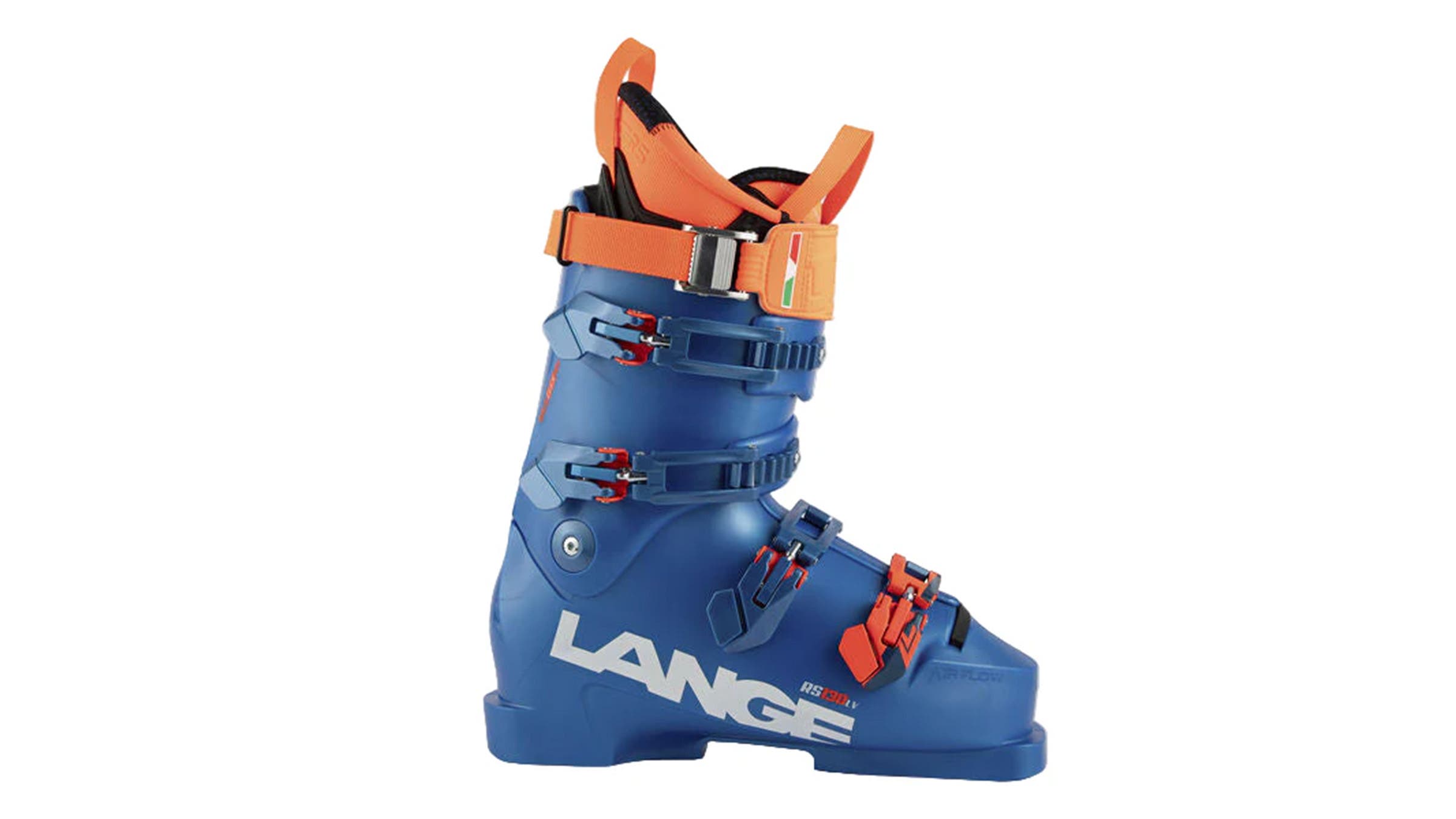
Best for Carvers: Lange RS
Sizes available: 22.5-30.5 (men’s); 21.5-28.5 (women’s)
Volume/Last options: LV (97 mm); MV (100 mm)
Flex options: 130, 120, 110 (men’s); 120, 110, 90, 70 (women’s)
Pros and Cons
+ Snug, narrow fit
+ Secure heel pocket
+ Precise edge control and steering
– Smooth sole (no GripWalk)
There’s a reason you still see that iconic blue Lange RS boot lined up outside every race lodge from Vermont to Verbier. Built off Lange’s deep racing heritage, the RS family has long been the benchmark for precision, power, and a locked-in fit that makes good skiers better. But this isn’t just a World Cup boot anymore—it’s evolved into a versatile, performance-minded series available in low- and mid-volume fits, with flex options from 130 down to 70, plus a short-cuff (SC) version built specifically for women.
What sets the Lange RS apart is how refined it feels. Recent updates to the shell and liner help the boot wrap the foot more naturally, with a lower instep that holds you securely down and back, and a reshaped liner tongue that supports the top of the foot without pressure points. The heel pocket is deep and contoured, locking the foot in place while still allowing a bit of natural movement.
On snow, the Lange RS delivers everything you’d expect from a boot with race DNA—clean energy transfer, laser-like edge control, and that addicting, stable feel that makes carving hardpack so satisfying. But it’s not limited to groomers: Testers found it powerful enough for wide skis and mixed terrain, too.
It’s worth noting that the smooth sole isn’t built for hiking or easily navigating icy parking lots. But what you lose in control in the parking lot you gain on snow, where this boot helps you feel perfectly connected to your skis. Whether you’re hammering gates, arcing morning corduroy, or just chasing that race-bred precision, there’s an RS model that fits the way you ski—as long as you have narrow-to-medium-wide feet.

Best Backcountry Hybrid: Tecnica Cochise
Sizes available: 24.5-30.5 (men’s); 22-27.5 (women’s)
Volume/Last options: 99 mm (MV); 102 mm (HV)
Flex options: 130, 120, 110 (men’s); 115, 105, 95
Pros and Cons
+ Skis like an alpine boot
+ Ideal narrow-medium fit
+ Updated liner improves entry
– Not ideal for long tours
The Tecnica Cochise has earned a reputation as a backcountry all-arounder—and for good reason. Available in men’s and women’s models, with flexes ranging from 130 down to 95 and high-volume options for men, the Cochise offers something for nearly every aggressive freerider. It straddles the line between tech-compatible backcountry boots and resort-focused alpine models, leaning firmly toward the downhill performance.
Testers praised the Cochise for fit and on-snow feel: It holds the foot securely, tracks precisely, and charges through challenging terrain with confidence. A new, stiffer liner slides effortlessly into place without bunching and snugly wraps the heel. Other improvements in this year’s model: Tecnica got rid of the lock-out switch on the cuff (which no one used, anyway) and a fussy buckle catch that made quick adjustments and transitions a chore.
The trade-off? The Cochise is heavy (around 1,850 grams per boot) and has a limited cuff range of motion, so it can’t match the fast, light touring boots designed for long uphill missions. But that’s not what it’s built for. For confident skiers who put downhill performance first—charging descents, sidecountry laps, or technical freeride lines—the Cochise delivers. Its power, stability, and responsiveness make it a reliable backcountry-meets-resort boot for all-day confidence in varied snow and terrain.
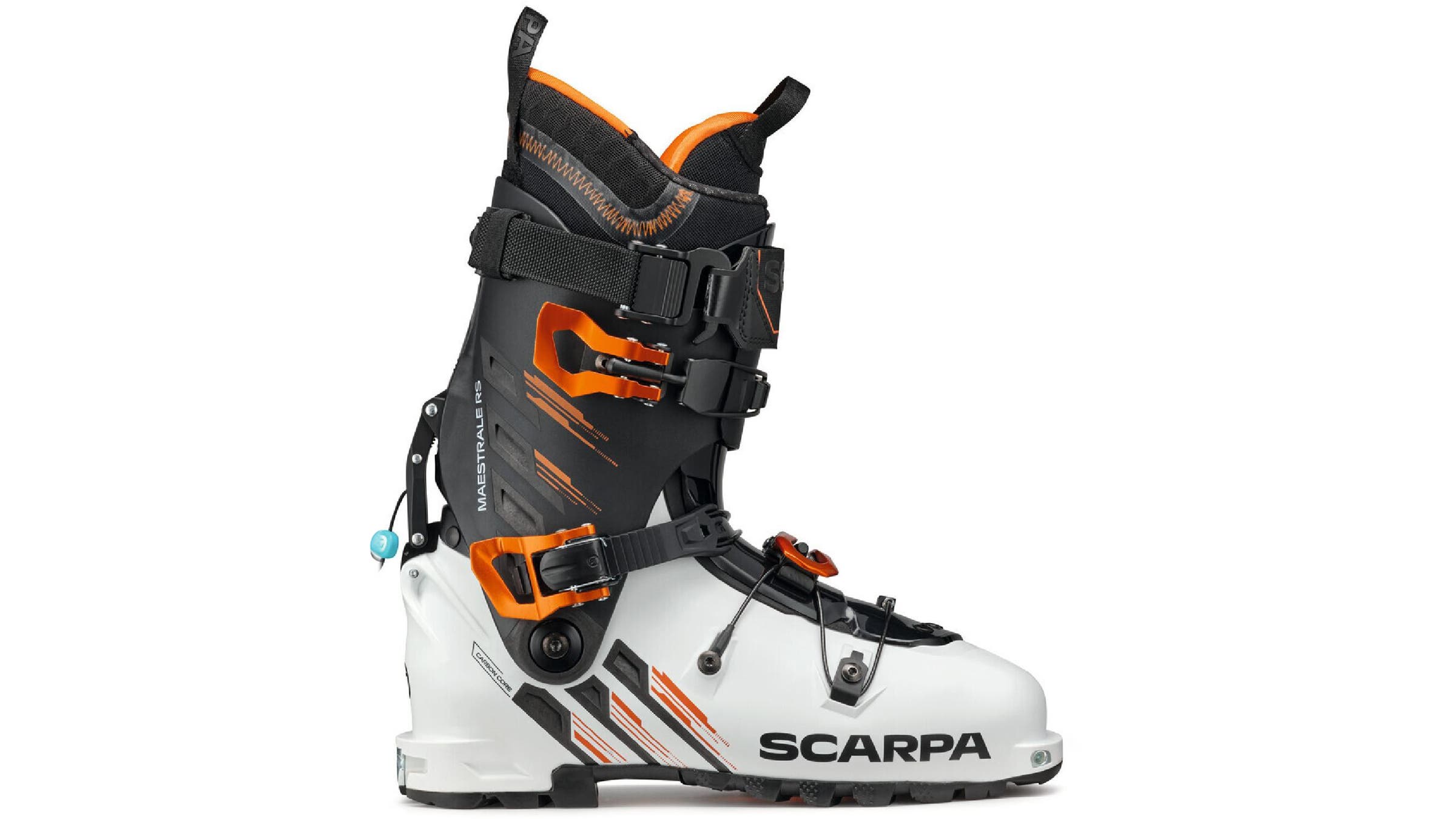
Best for Touring: Scarpa Maestrale/Gea
Sizes available: 24.5-32.0 (men’s); 22.5-27 (women’s)
Volume/Last options: 102 mm
Flex options: 125 (Maestrala RS), 110 (Maestrale); 120 (Gea RS), 100 (Gea)
Pros and Cons
+ Comfortable, efficient touring
+ Responsive on the descent
+ Lightweight
– Complicated buckle system
The Scarpa Maestrale (and its women’s counterpart, the Gea) prove that uphill efficiency and downhill performance don’t have to be mutually exclusive. Long a favorite among backcountry skiers and guides who spend more time skinning and hiking than riding lifts, these boots hit a rare balance: light enough for big days in the mountains, but still strong and stable when it’s time to point the skis downhill.
With a 102-millimeter last, the Maestrale fits a wide range of feet right out of the box. Testers liked how the pre-molded, well-padded liner felt broken-in from day one. It’s the kind of boot you can tour in for hours without thinking about your feet, which is the highest praise for a backcountry ski boot.
Scarpa builds the Maestrale and Gea from plant-based plastics—Grilamid Bio in the lower shell and Pebax Rnew in the cuff—reinforced with an internal carbon frame for torsional stiffness. The result is a boot that climbs smoothly and weighs less than it should, yet still has the backbone to drive mid-fat skis through variable snow. It’s not quite as powerful as Scarpa’s freeride-oriented 4-Quattro Pro, but for most human-powered days, it’s plenty of boot.
Testers also appreciated the Maestrale’s clean, functional design. The buckles and walk/ski mechanisms are easy to operate, and the hardware holds up to serious use. The only complaint? Getting the multiple cuff layers and buckles lined up when closing the boot takes some patience.
For skiers who measure their days in vertical gain but still expect a confident ride on the descent, the Maestrale/Gea strike one of the best balances in the backcountry ski boot category.
Ski Boot Buying Guide
What is the best ski boot brand?
Lange, Nordica, Salomon, Rossignol, and Tecnica make some of our favorite ski boots of 2026. That said, the best ski boot brand is the one that makes a ski boot that fits your foot like the proverbial glove. The best ski boot for you depends on your foot shape, skiing ability, style, and goals. The best way to find the best ski boot for your individual needs is to visit a reputable ski shop or professional bootfitter.
What is ski boot flex?
The flex index is a number that indicates how soft or firm a boot feels when you flex forward. The higher the number, the stiffer the boot. Flex ratings range widely—from about 70 for a soft women’s boot up to 140 for the stiffest non-race men’s models.
What is ski boot last/volume?
A ski boot’s last number (in millimeters) indicates the internal width of the boot at the forefoot, measured on a size 26/26.5 shell. While that number reflects a ski boot’s width, it’s also tied to the boot’s overall volume—how much total space there is inside. Volume includes the height over the instep (top of the foot) and the room in the cuff around the lower leg. In general, narrow boots also have a lower instep and tighter cuff, while wider boots have a higher instep and roomier cuff.
Do you need to own your own ski boots?
Ski boots are expensive, so it’s worth renting until you’ve decided to commit to the sport. If you start skiing five or more days a season, it’s worth buying your own pair of ski boots that fit your foot, ability level, and skiing style. Nothing will make you feel more comfortable and confident on the ski hill than ski boots that fit your feet well.
How much do good ski boots cost?
Ski boot prices generally range from $400 to $1,000, depending on the brand and specific model. In general, ski boots with a softer flex are less expensive than those with a stiffer flex because they use more affordable materials and are geared towards more novice skiers. The most expensive ski boots are high-performance models built for experts.
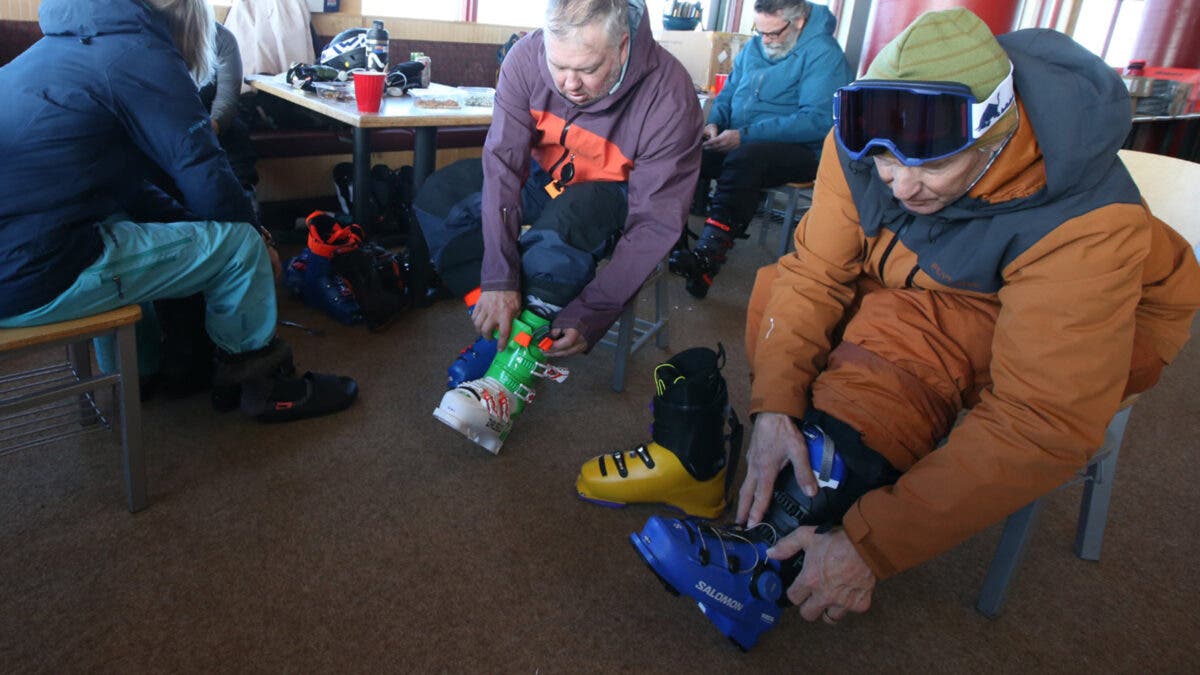
How We Test Ski Boots
Outside partners with the experts at SKI and Masterfit/America’s Best Bootfitters to bring you the most reliable ski boot reviews in the industry. Each year, Masterfit’s team of professional bootfitters and expert skiers conducts one of the most comprehensive boot tests in the business at Mt. Bachelor, Oregon.
This year, they tested 80 boots over eight days, logging roughly 6,000 vertical feet in each. Twenty expert testers—an even mix of men and women—evaluated every model across a range of snow conditions, comparing boots within their intended category and fit group (low-, medium-, and high-volume).
Each boot is scored on 15 detailed fit and stance parameters and six key performance metrics: initial fit, on-snow fit, stance, edge power, quickness, and features. Testers use a custom smartphone app to log real-time feedback on everything from flex feel to warmth and ease of entry.
This rigorous process allows Outside and SKI to deliver honest, data-driven recommendations across all boot categories—from frontside and all-mountain to backcountry—so you can find the best fit for your skiing style and ability.
Meet the Ski Boot Experts
Mark Elling
Mark Elling has worked full-time in the ski industry for over 35 years as a level 3 PSIA certified instructor, a snowcat skiing guide, and as a professional bootfitter. He runs a small bootfitting lab in Bend, Oregon, and also works on-mountain, selling and fitting boots at Mt. Bachelor Sports Pro Shop. Elling coordinates Masterfit’s annual boot test and writes the reviews that appear here and on the America’s Best Bootfitters website. He is formerly a board-certified pedorthist and is the author of The All-Mountain Skier: The Way to Expert Skiing.
Steve Cohen
Executive Editor of SKI Magazine from 1981 to 1994, Cohen, along with Jeff Rich, co-founded SKI’s on-hill boot test program in 1987. Cohen has been testing ski boots every year since. He and Rich founded the bootfit specialty company Masterfit Enterprises in 1994. The company teaches bootfitting at its Masterfit University, operates an organization of top bootfitting shops called America’s Best Bootfitters, and manufacturers aftermarket insoles for snow, cycling, and other sports. These days, Cohen mostly skis steep groomers and not-too-deep powder. He adopted the Lange Shadow 130 MV last year as his daily driver boot—the first Lange that’s ever fit his foot.
More from the 2026 Winter Gear Guide
The Best Skis of 2026
The Best Ski Jackets
The Best Midlayers